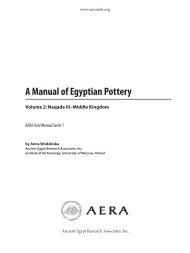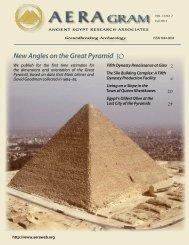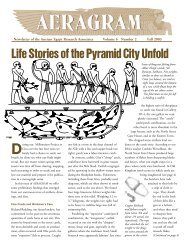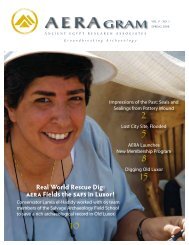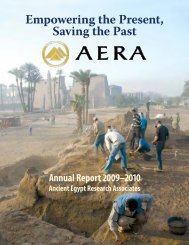The Khentkawes Town (KKT) - Ancient Egypt Research Associates
The Khentkawes Town (KKT) - Ancient Egypt Research Associates
The Khentkawes Town (KKT) - Ancient Egypt Research Associates
Create successful ePaper yourself
Turn your PDF publications into a flip-book with our unique Google optimized e-Paper software.
www.aeraweb.org<br />
crucial in order to determine the occurrence of disease<br />
types and age-related changes. It is also decisive for<br />
identifying gender dimorphism in occupation, lifestyle,<br />
and diet, as well as the role of different age groups in<br />
society.<br />
Preservation<br />
No single factor determines the preservation of skeletal<br />
remains. Differential preservation may occur between<br />
individuals of different sex, age and size, as well as between<br />
bones of varying density from the same individual.<br />
Burial environment and disposition of the remains<br />
(Roksandic 2002), incomplete excavation and postdepositional<br />
disturbance, as well as excavation and postexcavation<br />
loss of skeletal material (Ubelaker 1981: 177)<br />
can also influence bone condition. At aera, we calculate<br />
a preservation score for each burial by scoring 7 paired<br />
standard measurements for sub-adults and 18 paired and 5<br />
unpaired for measurements for adults, as well as presence<br />
or absence of 5 paired and 6 unpaired selected skeletal<br />
landmarks for sub-adults and 8 paired and 5 unpaired<br />
skeletal landmarks for adults. Paired measurements<br />
are ones taken on bones that occur on both the left and<br />
right side of the body, such as the long bones; femur and<br />
humerus for example. Unpaired bones are those of which<br />
the human body only contains one, such as the sacrum<br />
or the occipital. <strong>The</strong> total for each skeleton is divided by<br />
the highest obtainable score, so that a perfectly preserved<br />
skeleton will have a taphonomy score of one, and any<br />
missing values would result in a total of less than one.<br />
<strong>The</strong> preservation of the <strong>KKT</strong> burials was generally very<br />
poor, due to the fact that several of the burials had been<br />
truncated, most likely by the Selim Hassan excavations in<br />
the 1930s, and that the area was left open after the excavations<br />
concluded. All of the burials were extremely fragmentary,<br />
and in several of the cuts only a small percentage<br />
of the skeleton remained. Further, two of the more<br />
intact burials were covered with layers of heavy limestone<br />
blocks, which crushed the underlying bones. <strong>The</strong> taphonomy<br />
score of the first three burials excavated in March<br />
averaged as 0.03, substantially below the 0.16 which is the<br />
lowest recorded score from Area A in the HeG site south<br />
of the Wall of the Crow. <strong>The</strong> taphonomy score for the six<br />
burials excavated in April is awaiting final analysis in the<br />
storeroom, but is also expected to be very low.<br />
Minimum Number of Individuals<br />
As standard procedure, a count of the “minimum number<br />
of individuals” (MNI) is carried out on all material excavated<br />
at AERA, in order to establish how many individuals<br />
are represented by the articulated and disarticulated<br />
human bones recovered during excavation. <strong>The</strong> MNI<br />
is calculated by counting duplicates of identified and<br />
sided skeletal elements. <strong>The</strong> provisional MNI of the <strong>KKT</strong><br />
burials from 2008 was 10, but this number may have to<br />
be amended once final analysis has been carried out for<br />
all burials.<br />
Age Assessment<br />
Bones and teeth form and grow in relatively predictable<br />
patterns up until approximately 25 years of age, when<br />
the skeleton is completely formed. Following complete<br />
formation of the skeleton, degeneration of skeletal<br />
elements and dental wear can be utilized to assess the age<br />
of older individuals. Data from comparative materials<br />
of individuals of known ages are used for comparison<br />
(Brothwell 1981; Buikstra and Ubelaker 1994; Cox 2000;<br />
Ubelaker 1978; White and Folkens 2005). However,<br />
since degenerative changes tend to vary with lifestyle,<br />
occupation, and health of the individual, age assessment<br />
is more secure in younger individuals, and age-brackets<br />
tend to widen with advanced age.<br />
<strong>The</strong> human dentition is constructed of dense, hard<br />
materials, relatively resistant to decay in the ground, and<br />
often outlasting bone. Consequently, the dentition plays<br />
an important role in the work of any anthropologist, especially<br />
when dealing with poorly preserved material. At<br />
AERA, we employed coding of dental-wear patterns according<br />
to Brothwell (1981) to assess the age-at-death of adult<br />
individuals, and eruption patterns according to Ubelaker<br />
(1978) for immature remains. Other methods used to determine<br />
age at death were as follows: age-related changes<br />
at the pubic symphysis according to Todd (1920; 1921) and<br />
Suchey/Brooks (1990), modal age-related changes to the<br />
auricular surface of the coxae according to Lovejoy et al.<br />
(1985), sternal-end ossification of the fourth rib according<br />
to İşcan et al. (1984), and progression of endosteal reabsorption<br />
of the cortex with concomitant expansion of the<br />
marrow cavity according to Acsádi and Nemeskéri (1970).<br />
<strong>The</strong> latter method is based on trabecular patterns and, as<br />
such, could only be used when the bone in question was<br />
already fragmentary since no radiographic equipment was<br />
available for use. Each criterion was then weighed in order<br />
to arrive at an age assessment for each individual. <strong>The</strong><br />
sample was divided into age groups after Sjøvold (1978) in<br />
the following way:<br />
Infant<br />
0–1 years<br />
Infans I<br />
0–7 years<br />
Infans II<br />
5–14 years<br />
Juvenilis<br />
10–24 years<br />
Adultus<br />
18–44 years<br />
Maturus<br />
35–64 years<br />
Senilis<br />
50–79 years<br />
Adult*<br />
18–79 years<br />
*(includes the groups Adultus, Maturus, and Senilis)<br />
50<br />
Giza Plateau Mapping Project Season 2008 Preliminary Report





